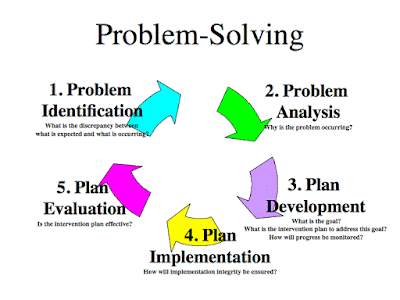The demand for students
that can successfully problem solve is a skill that the workforce is looking
for in prospective employees. Many
teachers are revising their curricula to encourage higher orders of thinking on
their students. When problem solving
students go through three cognitive activities to find a solution to the
problem.
1.
Represent Problem- Students find
appropriate context knowledge, and seek the end goal and starting conditions of
the problem.
2.
Solution Search- During this stage
students refine the goal they are seeking and develop a plan of action to reach
their end goal
3.
Implement Solution- Students execute
their plan of action and then evaluate the results.
When implementing
problem solving through the use of projects there are eight important steps to
consider making the assignment purposeful and meaningful for your students.
1.
Identify the significant content you
want your students to fully understand.
Outline the basis of the important knowledge you would like students to
become familiar with. This should
reflect what you as an educator believes are essential for their learning
process on the topic. In turn students
will find material and terms they believe are significant in their own lives.
2.
Grab students attention from the get
go! Provide an “entry event” that gets
the students interested and engaged.
Some examples are video clips, group discussion, guest speaker, and a
field trip. Sparking students’ interest
rather than passing out a handout and telling them they need to know this
because it is on the test is a poor way to get students to fully use their
problem solving skills.
3.
Be sure to have a driving question. A clear driving question provides a sense of
reasoning for the assignment and also a challenge presented to them.
4.
Allow for student input. Provide multiple outlets for completing the
project. Allow for a written paper, oral
presentation, and media technology.
Students articulate and solve problems in many ways don’t constrict your
students learning and thought process.
5.
Create a project replicated to the
workforce. Allow for collaboration,
communication, critical thinking, and the use of technology. Incorporating these facets into your assignment
create purpose and allow for reflection.
6.
Dig deeper. Have students ask questions and stem off of
topics already being examined. Students
find more meaning in work when they can relate it to real life issues.
7.
Feedback & Revision. In doing this students realize the importance
of creating high quality products and that their first attempt at something is
usually not their last. It explicitly
relates to the workforce and that revisions are an integral part of creating high
quality products.
8.
Present your product! Show off your work. Present how you arrived to your final
solution.
In conclusion when
creating an assignment centered on problem solving make it meaningful! Do not create it just for the sake of completing
the assigned material and moving on to take the test. Upon completion of the project have students
present their findings or creation to an audience. Students care more about the quality of their
research and problem solving strategies when they know they have to present
it. Doing this students acquire a taste
of what professionals in the workforce are looking for, after all isn’t that
what we as educators are preparing our students for? Real world experiences in an atmosphere where
they can succeed and fail without any repercussions.

Mason,
ReplyDeleteGood post. When you share a link, try writing the APA citation in your post with link afterward so people can see who wrote it etc.
What do you want to teach with PBL?
Animal genetics and tissue development
ReplyDelete